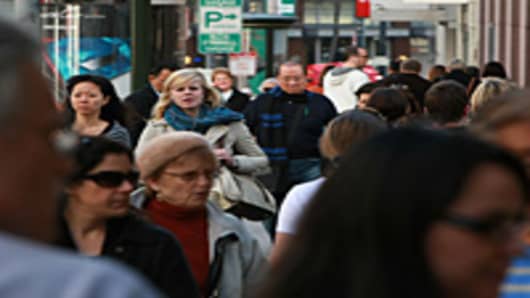Early signs are showing that retailers had a happy holiday, but investors should remember that there are still five critical weeks left in the holiday quarter for many retailers.
"Gift cards are a very large part of the season, and you got to include January sales," said Bob Duffy, a retail analyst at FTI. Retailers don't book gift card sales until the cards are redeemed.
"I think in order to really evaluate the Christmas season, you have to wait and see what happens in January," Duffy added. "It's almost like calling a baseball game after the seventh inning, and really not taking into account what happens in the eighth and ninth innings."
No doubt there is plenty of time for retailers' fortunes to turn. MasterCard Advisors' SpendingPulse estimates retail sales rose 3.6 percent from Nov. 1 through Dec. 24, compared with a 2.3 percent drop in the year-ago period. However, adjusting for an extra shopping day between Thanksgiving and Christmas, the number was closer to a 1 percent gain.
But those next few weeks are important, and gift cards sales were weak. That means merchants will need to work harder to lure shoppers back to the stores.
According to Wall Street Strategies analyst Brian Sozzi, there were good crowds at the Long Island, New York, malls and outlets he visited over the holiday weekend.
He said many retailers were taking advantage of the post-Christmas traffic to drum up sales for January. For example, he said Gap's Banana Republic was "a clear winner." The retailer has a promotion aimed at getting people back in the store in January by offering 40 percent off on one full-price item on four specific dates.
This type of promotion is likely to resonante with consumers, who have been very conscious of using sales and other discounts in order to make their money go further.
Although the official word from many retailers won't come until Jan. 7, when retailers issue their same-store sales results, there are clues about how the season shaped up.
On average, the post-Christmas discounting appears to be contained, with price cuts ranging from 70 percent to 50 percent at specialty stores and about 50 percent at most department stores.
Retailers headed into the holidays with lean inventories, and it shows as some store shelves were picked over. This could help to move new full-price items that were brought in to entice shoppers as they come back to the stores to return gifts or buy discounted merchandise.
However, it does seem that the retailers who tempted consumers the most with discounts may be the ones that will reap the biggest rewards.
Britt Beemer, chairman of America's Research Group, expects discounters and off-price stores like TJX Cos. and Ross Stores will fare the best.
One of the startling things Beemer discovered was that only about 78 percent of consumers finished their Christmas shopping this year. That was the lowest level in the 26 years Beemer's been collecting this data.
That means consumers may have given cash to relatives and friends in lieu of gifts. That's bad news for retailers as well.
According to Beemer, most people who receive cash as a gift use it to pay off bills, buy necessities like groceries, or treat themselves to a dinner at a restaurant rather than buying merchandise at a store.
Throughout the holiday season, Beemer has been predicting that retailers would see another decline in holiday season sales because as consumers cut back because of fears about their jobs, a need to pay off credit card bills or a desire to rebuild their retirement savings. About 98 percent of all Americans fall into at least one of those three categories, according to Beemer.
He expects that it will take until next Labor Day or even the spring of 2011 before consumers return to a somewhat normal spending pattern.
More from Consumer Nation:
- The Answer to YouTube's Ad Strategy? A Skateboarding Dog
- Traffic, Spending Up at America's Largest Mall
- Why Protecting Your Health Is Good for Business
Questions? Comments? Email us at consumernation@cnbc.com




